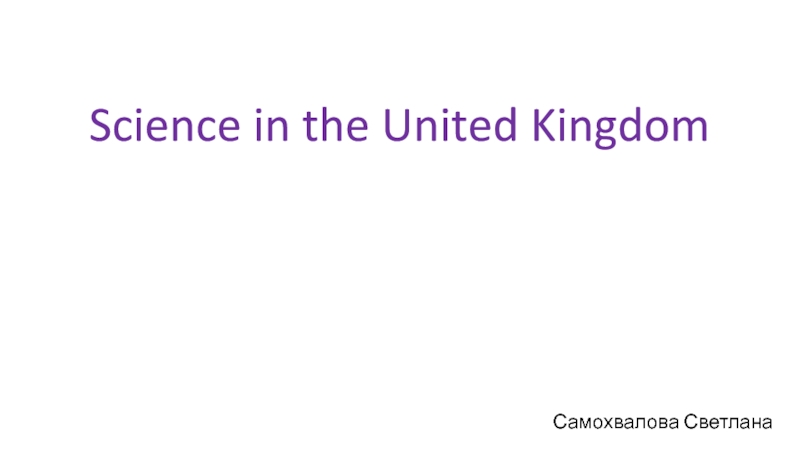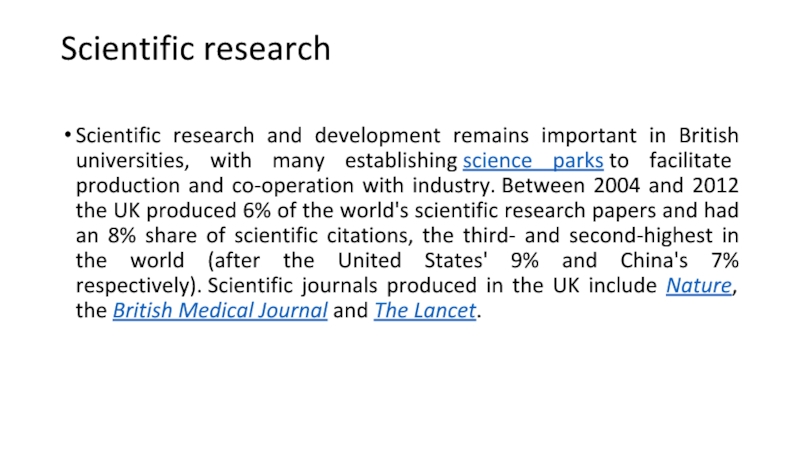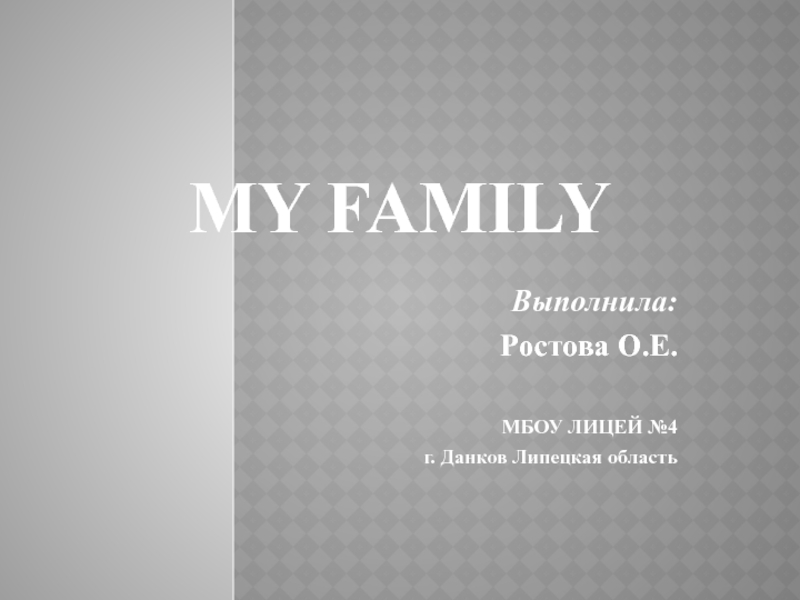- Главная
- Разное
- Образование
- Спорт
- Естествознание
- Природоведение
- Религиоведение
- Французский язык
- Черчение
- Английский язык
- Астрономия
- Алгебра
- Биология
- География
- Геометрия
- Детские презентации
- Информатика
- История
- Литература
- Математика
- Музыка
- МХК
- Немецкий язык
- ОБЖ
- Обществознание
- Окружающий мир
- Педагогика
- Русский язык
- Технология
- Физика
- Философия
- Химия
- Шаблоны, фоны, картинки для презентаций
- Экология
- Экономика
Презентация, доклад Science in the United Kingdom
Содержание
- 1. Презентация Science in the United Kingdom
- 2. Science in the United Kingdom has a long
- 3. A Watt steam engine, which powered
- 4. Major theories, discoveries and applications advanced by
- 5. The discovery of hydrogen, by Henry Cavendish (1731–1810). The steam locomotive,
- 6. Evolution by natural selection, by Charles Darwin (1809–82)
- 7. The first practical telephone, patented by Alexander Graham Bell (1847–1922).The
- 8. Stephen William
- 9. Stephen Hawking holding a public lecture at the Stockholm Waterfront congress center, 24 August 2015.
- 10. The invention of the World Wide Web, by Tim
- 11. Technology-based industries The UK plays a leading
- 12. Scientific research Scientific research and development remains
- 13. Government Office for Science The Government Office for
- 14. List of UK government scientific research institutes
- 15. 2 Science and Technology Facilities Council3 Department
- 16. The UK continues to play a major
Science in the United Kingdom has a long history, producing many important figures and developments in the field. England and Scotland were leading centers of the Scientific Revolution from the 17th century and the United Kingdom led the Industrial Revolution from the
Слайд 2Science in the United Kingdom has a long history, producing many important
figures and developments in the field.
England and Scotland were leading centers of the Scientific Revolution from the 17th century and the United Kingdom led the Industrial Revolution from the 18th century, and has continued to produce scientists and engineers credited with important advances.[
England and Scotland were leading centers of the Scientific Revolution from the 17th century and the United Kingdom led the Industrial Revolution from the 18th century, and has continued to produce scientists and engineers credited with important advances.[
Слайд 3 A Watt steam engine, which powered the Industrial Revolution in
the United Kingdom and played a key role in it becoming the world's first industrialized nation
Слайд 4Major theories, discoveries and applications advanced by people from the UK
The laws
of motion and illumination of gravity, by physicist, mathematician, astronomer, natural philosopher, alchemist and theologian, Sir Isaac Newton (1643–1727), the founder of modern physics and mathematics.
Слайд 5The discovery of hydrogen, by Henry Cavendish (1731–1810).
The steam locomotive, by Richard Trevithick (1771–1833) and Andrew Vivian (1759–1842).
The electric
motor, by Michael Faraday (1771–1867), who largely made electricity viable for use in technology.
The theory of aerodynamics, by Sir George Cayley (1773–1857).
The first public steam railway, by George Stephenson (1781–1848).
The first commercial electrical telegraph, co-invented by Sir William Fothergill Cooke (1806–79) and Charles Wheatstone (1802–75).
First tunnel under a navigable river, first all iron ship and first railway to run express services, contributed to by Isambard Kingdom Brunel (1806–59)
The theory of aerodynamics, by Sir George Cayley (1773–1857).
The first public steam railway, by George Stephenson (1781–1848).
The first commercial electrical telegraph, co-invented by Sir William Fothergill Cooke (1806–79) and Charles Wheatstone (1802–75).
First tunnel under a navigable river, first all iron ship and first railway to run express services, contributed to by Isambard Kingdom Brunel (1806–59)
Слайд 6Evolution by natural selection, by Charles Darwin (1809–82)
Natural selection is
one of the cornerstones of modern biology. The union of traditional Darwinian evolution with subsequent discoveries in classical and molecular genetics is termed the modern evolutionary synthesis. Natural selection remains the primary explanation for adaptive evolution.
Слайд 7The first practical telephone, patented by Alexander Graham Bell (1847–1922).
The discovery of penicillin, by biologist and pharmacologist, Sir Alexander
Fleming (1881–1955).
The world's first working television system, and colour television, by John Logie Baird (1888–1946).
The first meaningful synthesis of quantum mechanics with special relativity by Paul Dirac (1902–84) in the equation named after him, and his subsequent prediction of antimatter.
The invention of the jet engine, by Frank Whittle (1907–96).
The invention of the hovercraft, by Christopher Cockerell (1910–99).
The colossus computer, by Alan Turing (1912–54), the first digital computer (a code breaker in WWII made in Bletchley Park) computer.
The structure of DNA, by Francis Crick (1916–2004) and others.
The theoretical breakthrough of the Higgs mechanism to explain electroweak symmetry breaking and why some particles have mass, by Peter Higgs (1929-).
Theories in cosmology, quantum gravity and black holes, by Stephen Hawking (1942–).
The world's first working television system, and colour television, by John Logie Baird (1888–1946).
The first meaningful synthesis of quantum mechanics with special relativity by Paul Dirac (1902–84) in the equation named after him, and his subsequent prediction of antimatter.
The invention of the jet engine, by Frank Whittle (1907–96).
The invention of the hovercraft, by Christopher Cockerell (1910–99).
The colossus computer, by Alan Turing (1912–54), the first digital computer (a code breaker in WWII made in Bletchley Park) computer.
The structure of DNA, by Francis Crick (1916–2004) and others.
The theoretical breakthrough of the Higgs mechanism to explain electroweak symmetry breaking and why some particles have mass, by Peter Higgs (1929-).
Theories in cosmology, quantum gravity and black holes, by Stephen Hawking (1942–).
Слайд 8 Stephen William Hawking CH, CBE, FRS, FRSA ( i/ˈstiːvən ˈhɔːkɪŋ/; born 8 January
1942) is an English theoretical physicist, cosmologist, author and Director of Research at the Centre for Theoretical Cosmology within the University of Cambridge. His scientific works include a collaboration with Roger Penrose on gravitational singularity theorems in the framework of general relativity, and the theoretical prediction that black holes emit radiation, often called Hawking radiation. Hawking was the first to set forth a theory of cosmology explained by a union of the general theory of relativity and quantum mechanics. He is a vigorous supporter of the many-worlds interpretation of quantum mechanics.
He is an Honorary Fellow of the Royal Society of Arts, a lifetime member of the Pontifical Academy of Sciences, and a recipient of the Presidential Medal of Freedom, the highest civilian award in the United States. Hawking was the Lucasian Professor of Mathematics at the University of Cambridge between 1979 and 2009 and has achieved commercial success with works of popular science in which he discusses his own theories and cosmology in general; his book A Brief History of Time appeared on the British Sunday Times best-seller list for a record-breaking 237 weeks.
Hawking suffers from a rare early-onset, slow-progressing form of amyotrophic lateral sclerosis (ALS), commonly known as motor neurone disease in the UK, that has gradually paralysed him over the decades.[20][21] He now communicates using a single cheek muscle attached to a speech-generating device. Hawking married twice and has three children
He is an Honorary Fellow of the Royal Society of Arts, a lifetime member of the Pontifical Academy of Sciences, and a recipient of the Presidential Medal of Freedom, the highest civilian award in the United States. Hawking was the Lucasian Professor of Mathematics at the University of Cambridge between 1979 and 2009 and has achieved commercial success with works of popular science in which he discusses his own theories and cosmology in general; his book A Brief History of Time appeared on the British Sunday Times best-seller list for a record-breaking 237 weeks.
Hawking suffers from a rare early-onset, slow-progressing form of amyotrophic lateral sclerosis (ALS), commonly known as motor neurone disease in the UK, that has gradually paralysed him over the decades.[20][21] He now communicates using a single cheek muscle attached to a speech-generating device. Hawking married twice and has three children
Слайд 9Stephen Hawking holding a public lecture at the Stockholm Waterfront congress center, 24
August 2015.
Слайд 10The invention of the World Wide Web, by Tim Berners-Lee (1989).
Sir Timothy John Berners-Lee OM KBE FRS FREng FRSA FBCS (born 8 June 1955), also known as TimBL, is an English computer scientist, best known as the inventor of the World Wide Web. He made a proposal for an information management system in March 1989, and he implemented the first successful communication between a Hypertext Transfer Protocol (HTTP) client and server via the Internet sometime around mid-November of that same year.[4][5][6][7][8]
Berners-Lee is the director of the World Wide Web Consortium (W3C), which oversees the Web's continued development. He is also the founder of the World Wide Web Foundation, and is a senior researcher and holder of the Founders Chair at the MIT Computer Science and Artificial Intelligence Laboratory (CSAIL). He is a director of the Web Science Research Initiative (WSRI), and a member of the advisory board of the MIT Center for Collective Intelligence. In 2011 he was named as a member the Board of Trustees of the Ford Foundation.
In 2004, Berners-Lee was knighted by Queen Elizabeth II for his pioneering work. In April 2009, he was elected a foreign associate of the United States National Academy of Sciences.[16][17] He was honored as the "Inventor of the World Wide Web" during the 2012 Summer Olympics opening ceremony, in which he appeared in person, working with a vintage NeXT Computer at the London Olympic Stadium. He tweeted "This is for everyone", which instantly was spelled out in LCD lights attached to the chairs of the 80,000 people in the audience.
Berners-Lee is the director of the World Wide Web Consortium (W3C), which oversees the Web's continued development. He is also the founder of the World Wide Web Foundation, and is a senior researcher and holder of the Founders Chair at the MIT Computer Science and Artificial Intelligence Laboratory (CSAIL). He is a director of the Web Science Research Initiative (WSRI), and a member of the advisory board of the MIT Center for Collective Intelligence. In 2011 he was named as a member the Board of Trustees of the Ford Foundation.
In 2004, Berners-Lee was knighted by Queen Elizabeth II for his pioneering work. In April 2009, he was elected a foreign associate of the United States National Academy of Sciences.[16][17] He was honored as the "Inventor of the World Wide Web" during the 2012 Summer Olympics opening ceremony, in which he appeared in person, working with a vintage NeXT Computer at the London Olympic Stadium. He tweeted "This is for everyone", which instantly was spelled out in LCD lights attached to the chairs of the 80,000 people in the audience.
Слайд 11Technology-based industries
The UK plays a leading part in the aerospace industry, with companies
including Rolls-Royce playing a leading role in the aero-engine market; BAE Systems acting as Britain's largest and the Pentagon's sixth largest defense supplier, and large companies including GKN acting as major suppliers to the Airbus project. Two British-based companies, GlaxoSmithKline and AstraZeneca, ranked in the top five pharmaceutical companies in the world by sales in 2009 and UK companies have discovered and developed more leading medicines than any other country apart from the US. The UK remains a leading centre of automotive design and production, particularly of engines, and has around 2,600 component manufacturers.
The Airbus A380 has wings and engines manufactured in the UK.
Слайд 12Scientific research
Scientific research and development remains important in British universities, with
many establishing science parks to facilitate production and co-operation with industry. Between 2004 and 2012 the UK produced 6% of the world's scientific research papers and had an 8% share of scientific citations, the third- and second-highest in the world (after the United States' 9% and China's 7% respectively). Scientific journals produced in the UK include Nature, the British Medical Journal and The Lancet.
Слайд 13Government Office for Science
The Government Office for Science is part of the British government.
This organization advises the UK Government on policy and decision-making based on robust scientific evidence and long-term thinking. It is led by the Government Chief Scientific Adviser (GCSA), Sir Mark Walport who reports to the Prime Minister and Cabinet.
The office is based in the Department for Business, Innovation and Skills where it works with other parts of the Department, including the Science and Research Group, which funds research through Research Councils and the Higher Education Funding Council for England.
The office is based in the Department for Business, Innovation and Skills where it works with other parts of the Department, including the Science and Research Group, which funds research through Research Councils and the Higher Education Funding Council for England.
Слайд 14List of UK government scientific research institutes
Biotechnology and Biological Sciences Research
Council
Babraham Institute
Pirbright Institute
Institute of Food Research
Institute of Grassland and Environmental Research
John Innes Centre
Roslin Institute
Rothamsted Research
Silsoe Research Institute (ceased operations in 2006)
Babraham Institute
Pirbright Institute
Institute of Food Research
Institute of Grassland and Environmental Research
John Innes Centre
Roslin Institute
Rothamsted Research
Silsoe Research Institute (ceased operations in 2006)
Слайд 15
2 Science and Technology Facilities Council
3 Department for Environment, Food and
Rural Affairs (Centre for Environment, Fisheries and Aquaculture Science)
4 Department of Health (National Radiological Protection Board)
5 Department for Business, Innovation and Skills
6 Ministry of Defence (Atomic Weapons Establishment, Defence Science and Technology Laboratory)
7 Medical Research Council
8 Natural Environment Research Council (British Antarctic Survey, British Geological Survey, Centre for Ecology and Hydrology, National Oceanography Centre, Plymouth Marine Laboratory, National Centre for Atmospheric Science)
9 Science and Technology Facilities Council (UK Astronomy Technology Centre)
4 Department of Health (National Radiological Protection Board)
5 Department for Business, Innovation and Skills
6 Ministry of Defence (Atomic Weapons Establishment, Defence Science and Technology Laboratory)
7 Medical Research Council
8 Natural Environment Research Council (British Antarctic Survey, British Geological Survey, Centre for Ecology and Hydrology, National Oceanography Centre, Plymouth Marine Laboratory, National Centre for Atmospheric Science)
9 Science and Technology Facilities Council (UK Astronomy Technology Centre)
Слайд 16The UK continues to play a major role in the development
of science and technology and major technological sectors include the aerospace, motor and pharmaceutical industries.
The Neuroscience of Learning
with Britt Andreatta





















